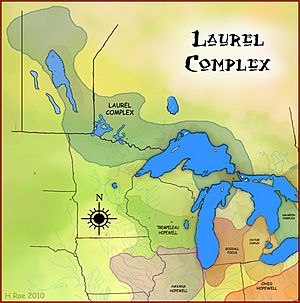Laurel complex facts for kids
The Laurel complex was a group of Native American people who lived a long time ago. They lived in parts of what is now Canada and the United States. You could find them in southern Quebec, Ontario, and Manitoba in Canada. In the U.S., they lived in northern Michigan, Wisconsin, and Minnesota. These people were special because they were the first in northern Ontario to use pottery. The name "Laurel complex" comes from a small place called Laurel in Minnesota.
Understanding the Hopewell Exchange System
The Hopewell Exchange System was a big trading network. It started around 300 BCE in the Ohio and Illinois River Valleys. It wasn't just one single culture. Instead, it was many different groups of people who traded with each other. This trading system was very wide. For example, they traded a black volcanic glass called obsidian from the Yellowstone area. They also traded copper from the Lake Superior region. And they got shells from the Gulf Coast.
The Laurel complex people were part of this larger Hopewell system. They built special mounds for ceremonies. Other groups in the Hopewell system, like the Point Peninsula complex, also built these mounds. Laurel complex sites were often near fast-moving water or waterfalls. This is where fish like sturgeon would come to lay their eggs. It's possible that their ceremonies happened at the same time as this yearly event.
The mounds and the items found inside them show that the Laurel complex people had contact with other groups. These groups included the Adena and Hopewell people from the Ohio River valley. We don't know if they traded directly or through other groups.
Kay-Nah-Chi-Wah-Nung: A Special Place
One important place for the Laurel culture was what is now the Kay-Nah-Chi-Wah-Nung National Historic Site of Canada. The Laurel people lived here from about 2300 to 900 years ago. They lived in villages and built large, round burial mounds. These mounds were monuments to their dead. You can still see these mounds today.
Kay-Nah-Chi-Wah-Nung is considered one of the most important places in Canada for early settlements and ceremonial burials. It is located on the north side of the Rainy River in Northwestern Ontario, Canada. This site became a key part of the continent-wide trading network. This was because of its great location in the middle of major North American waterways.


